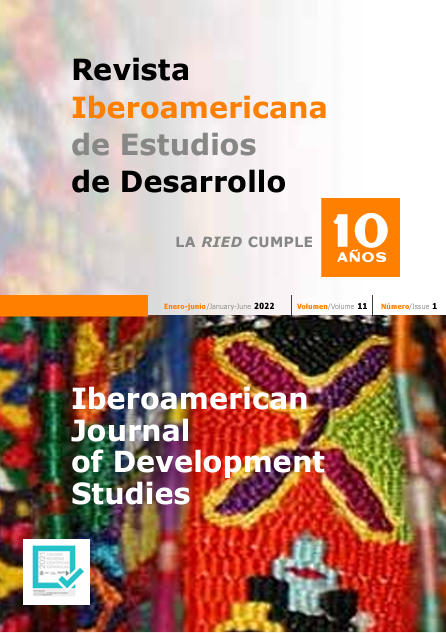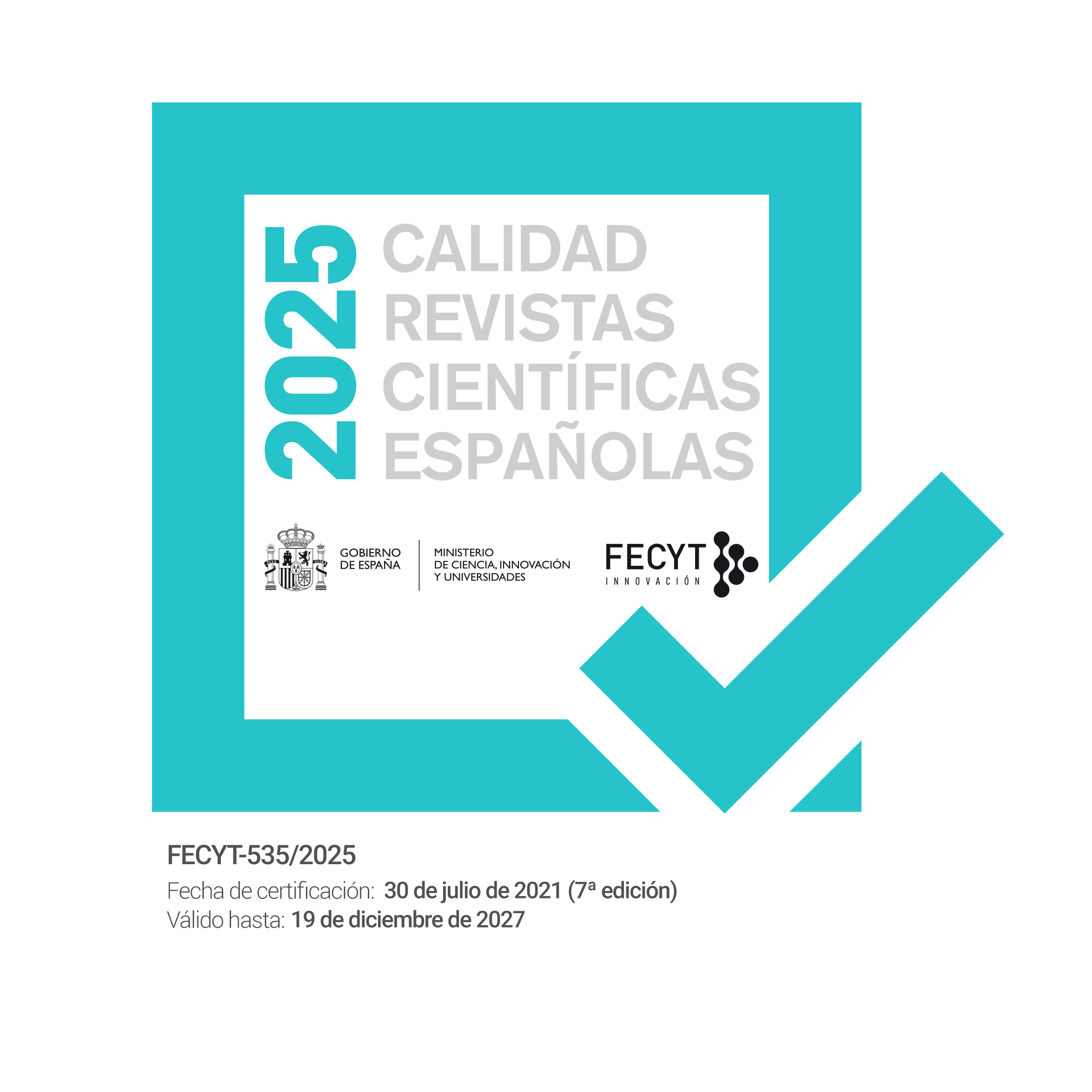¿Seguir o desafiar al mercado?: políticas de desarrollo productivo en los casos del sector forestal de Finlandia y Chile
DOI:
https://doi.org/10.26754/ojs_ried/ijds.573Palabras clave:
políticas de desarrollo productivo, Finlandia, Chile, ventajas comparativas, sector forestal, EstadoResumen
En el presente trabajo se muestra una revisión de la bibliografía relativa a las formas de intervención del Estado en el proceso de desarrollo económico, y se establece una tipología en la que se identifican tres categorías básicas: guardián, facilitador y empresario. Estas se diferencian de acuerdo con los niveles y áreas de intervención en el mercado, así como también según cuánto se adaptan o desafían a las ventajas comparativas dadas. A partir de esta tipología, se toman dos casos de crecimiento guiado por las exportaciones y la apertura comercial (Finlandia y Chile, desde de la década de los sesenta y setenta, respectivamente, hasta mediados de los noventa) para analizar la evolución de las formas de intervención que realizaron e identificar las diferencias que los llevaron a tener distintos desempeños económicos.
Descargas
Referencias
ACEMOGLU D, ROBINSON J. (2012). Por qué fracasan las naciones. Ediciones Deusto, Barcelona.
AIGINGER K, RODRIK D (2020). Rebirth of Industrial Policy and an Agenda for the Twenty-first Century. Journal of Industry, Competition and Trade 20:189-207.
ALI-YRKKÖ J, HERMANS R (2002). Nokia in the Finnish Innovation System. ETLA Discussion Papers n.º 811.
AMSDEN AH (1992). Asia’s Next Giant: South Korea and Late Industrialization. Oxford University Press, Nueva York.
AMSDEN AH (2001). The Rise of «The Rest»: Challenges to the West From Late-Industrializing Economies. Oxford University Press, Oxford.
ARAUCO (2004). Memoria Anual 2004. https://www.arauco.cl/wp-content/uploads/2017/07/Annual-Report-2004.pdf , acceso 21 julio 2020.
BANCO MUNDIAL (1993). The East Asian Miracle: Economic Growth and Public Policy: Main report. https://documents.worldbank.org/en/publication/documents-reports/documentdetail/975081468244550798/main-report , acceso 21 de julio de 2020.
BANCO MUNDIAL (2002). Globalización, crecimiento y pobreza: construyendo una economía mundial incluyente. Alfaomega, México D. F.
BANCO MUNDIAL (2020). Trading for Development in the Age of Global Value Chains. Banco Mundial, Washington.
BANCO MUNDIAL, CONAF (2020). Los bosques de Chile: pilar para un desarrollo inclusivo y sostenible. http://documents1.worldbank.org/curated/en/466411591268480067/pdf/Chile-s-Forests-A-Pillar-for-Inclusive-and-Sustainable-Development.pdf , acceso 21 de julio de 2020.
BLUTH SOLARI A (2013). El aporte de la Ingeniería Forestal al desarrollo del país. Una reseña histórica de la profesión forestal en Chile. Colegio de Ingenieros Forestales de Chile, Santiago.
BORREGAARD N, DUFEY A, WINCHESTER L (2008). Effects of foreign investment versus domestic investment on the forestry sector in Latin America (Chile and Brazil)-Demystifying FDI effects related to the Environment. Working Group on Development and Environment in the Americas. Discussion Paper n.º 15.
BRAVO-ORTEGA Á, GARCÍA C (2007). Cerrando la brecha innovativa latinoamericana: ¿qué podemos aprender de Corea, Israel y Finlandia? http://www.cieplan.org/wp-content/uploads/2019/12/serie-est-socioec-35.pdf , acceso 21 de julio de 2020.
CALDERÓN A (2005). Chile: Direct Investment Abroad and Internationalisation of Conglomerates. UNCTAD Expert Meeting on Enhancing the Productive Capacity of Developing Country Firms through Internationalization. Ginebra:5-7.
CASTELLS M, HIMANEN P (2002). The Information Society and the Welfare State: The Finnish Model. Oxford University Press on Demand, Nueva York.
CHANG H-J (2002). Kicking Away the Ladder. Anthem Press, Londres.
CHANG H-J (2009). Under-explored Treasure Troves of Development Lessons: Lessons from the Histories of Small Rich European Countries. Doing Good or Doing Better – Development Policies in a Globalising World, 81.
CHANG H-J, ANDREONI A (2020). Industrial Policy for the 21st Century. Development & Change 51(2):324-351.
CHERIF R, HASANOV F (2019). The Return of the Policy That Shall Not Be Named: Principles of Industrial Policy. International Monetary Fund, Working Paper n.º 19/74.
CMPC (2015). Empresas CMPC: 95 años de historia, presente y futuro. https://www.cmpc.com/empresas-cmpc-95-años-de-historia-presente-y-futuro/ , acceso 21 de julio de 2020.
COLLIER S, SATER W (1996). A History of Chile, 1808-1994. En: Cambridge Latin America, vol. I. Cambridge University Press, Cambridge.
CONAF (2020). Historia CONAF. Ministerio de Agricultura. https://www.conaf.cl/quienes-somos/historia/ , acceso 21 de julio de 2020.
CORD DJ (2014). The Decline and Fall of Nokia. Schildts & Söderströms, Helsinki.
CRUZ-COKE R (2004). Evolución de las universidades chilenas 1981-2004. Revista médica de Chile 132(12):1543-1549.
DECRETO 4363-LEY DE BOSQUES [DL 4363] n.º 4363 de 1931. 20 de junio de 1931 (Chile). https://www.leychile.cl/Navegar?idNorma=19422 , acceso 21 de julio de 2020.
DOLLAR D, KRAAY A (2001). Trade, Growth, and Poverty. The Economic Journal 114(493).
FAGERBERG J, HUTSCHENREITER G (2020). Coping with Societal Challenges: Lessons for Innovation Policy Governance. Journal of Industry, Competition and Trade 20:279-305.
FELLMAN S (2008). Growth and Investment: Finnish Capitalism, 1850-2005. En: Creating Nordic Capitalism: The Development of a Competitive Periphery. Palgrave Macmillan, Londres, 139-217.
FFRENCH-DAVIS R (2014). Entre el neoliberalismo y el crecimiento con equidad. J. Sáez Editor, Santiago.
FFRENCH-DAVIS R, DÍAZ A (2019). La inversión productiva en el desarrollo económico de Chile: evolución y desafíos. Revista Cepal, n.º 127: 27-53.
FFRENCH-DAVIS R, LEIVA P, MADRID R (1992). Liberalización comercial y crecimiento: la experiencia de Chile, 1973-89. Pensamiento Iberoamericano 21:33-55.
FOSTER C, AZMEH S (2020). Latecomer Economies and National Digital Policy: An Industrial Policy Perspective. The Journal of Development Studies 56(7):1247-1262.
FREDRICKSON JW (1960). The Economic Recovery of Finland Since World War II. Journal of Political Economy 68(1):17-36.
FRÊNE C, NÚÑEZ M (2010). Hacia un nuevo Modelo Forestal en Chile. http://www.sendadarwin.cl/espanol/wp-content/uploads/2011/06/frene-y-nunez.pdf , acceso 21 de julio de 2020.
GARDNER SL, EASTIN IL (2002). Chile’s Forest Products Industry: A Country Profile. Cintrafor, working paper n.º 90.
GNANGNON S (2020). Comparative Advantage Following (CAF) Development Strategy, Aid for Trade Flows and Structural Change in Production. Journal of Economic Structures 9(1):1-29.
GWYNNE RN (1996). Direct Foreign Investment and Non-Traditional Export Growth in Chile: The Case of the Forestry Sector. Bulletin of Latin American Research 15:341-357.
HAGGARD S (2018). Developmental States. Cambridge University Press, Cambridge.
HJERPPE R (1989). The Finnish Economy 1860-1985: Growth and Structural Change. Bank of Finland, Government Printing Centre, Helsinki.
JÄNTTI M, VARTIAINEN J (2009). The Finnish Developmental State and its Growth Regime. UNU-WIDER Research Paper, n.º 2009/35.
KATZ J, STUMPO G, VARELA F (2003). El complejo forestal chileno. En: Bercovich N, Katz J (eds.). El desarrollo de complejos forestales en América Latina. Cepal/Alfaomega, Bogotá, pp. 123-185.
KIM KM (2020). The Korean Developmental State. Palgrave Macmillan, Londres.
KRUEGER AO (1974). The Political Economy of the Rent-seeking Society. The American Economic Review 64(3):291-303.
KUISMA M. (1993). Government Action, Cartels, and National Corporations ‒ the Development Strategy of a Small Peripheral Nation During the Period of Crisis and Economic Disintegration in Europe (Finland 1918-1938). Scandinavian Economic History Review 41(3):242-268.
KURTZ M (2001). State Developmentalism Without a Developmental State: The Public Foundations of the «Free Market Miracle» in Chile. Latin American Politics and Society 43(2):1-25.
LIMA-TOIVANEN MB (2012). The South American Pulp and Paper Industry: The Cases Brazil, Chile, and Uruguay. En: Lamberg J, Ojala J, Peltoniemi M, Särkkä T (eds.). The Evolution of Global Paper Industry 1800-2050. World Forests 17:243-283.
LIN J (2012). The Quest for Prosperity: How Developing Countries Can Take Off. Princeton University Press, Nueva Jersey.
LIN J, CHANG H (2009). Should Industrial Policy in Developing Countries Conform to Comparative Advantage or Defy It? A Debate Between Justin Lin and Ha‐Joon Chang. Development Policy Review 27(5):483-502.
LIN J, MONGA C (2010). Growth Identification and Facilitation: The Role of the State in the Dynamics of Structural Change. World Bank, Nueva York.
LURASCHI M (2007). Análisis de la cadena productiva de la celulosa y el papel a la luz de los objetivos de desarrollo sostenible: estudio del caso de Chile. https://repositorio.cepal.org/bitstream/handle/11362/3596/1/S2007352_es.pdf , acceso 21 de julio de 2020.
MAZZUCATO M (2013). The Entrepreneurial State: Debunking Public vs. Private Sector Myths. PublicAffairs, Filadelfia.
MAZZUCATO M (2021). Mission Economy. A Moonshot Guide to Changing Capitalism. Harper Business, Londres.
MAZZUCATO M, PENNA C (2016). Beyond Market Failures: The Market Creating and Shaping Roles of State Investment Banks. Journal of Economic Policy Reform 19(4):305-326.
MIT (2020). OEC ‒ What does Chile export? (2017). The Observatory of Economic Complexity. https://oec.world/en/visualize/tree_map/hs92/export/chl/all/show/2017/ , acceso 21 de julio de 2020.
MONTOYA L (2004). Descripción y análisis de la política de incentivos para promover la reforestación en Chile. Revista Forestal KURÚ (Costa Rica) 1(2):1-11.
NIKLITSCHEK ME (2007). Trade Liberalization and Land Use Changes: Explaining the Expansion of Afforested Land in Chile. Forest Science 53(3):385-394.
NORTH DC (2004). Understanding the Process of Economic Change. Princeton University Press, Nueva York.
OCAMPO JA (2020). Industrial Policy, Macroeconomics and Structural Change. Columbia Center on Global Economic Governance, CDEP-CGEG WP, n.º 81.
OECD (2011). Globalisation, Comparative Advantage, and the Changing Dynamics of Trade. https://www.oecd.org/publications/globalisation-comparative-advantage-and-the-changing-dynamics-of-trade-9789264113084-en.htm , acceso 21 de julio de 2020.
OJALA J, LAMBERG JA, MELANDER A (2008). From State Ownership to MNC: The Path of Enso-Gutzeit to Stora-Enso. En: Fellman S, Jes Iversen M, Sjögren H, Thue L (eds.). Creating Nordic Capitalism: The Business History of a Competitive Periphery. Palgrave Macmillan, Nueva York, pp. 218-237.
OQUBAY A, OHNO K (ed.) (2019). How Nations Learn. Oxford University Press, Oxford.
OQUBAY A, CRAMER C, CHANG H-J, KOZUL-WRIGHT R (2020). The Oxford Handbook of Industrial Policy. Oxford University Press, Oxford.
ORNSTON D (2012). When Small States Make Big Leaps. Nueva York, Cornell University Press, Londres.
ORTEGA L (1995). La innovación tecnológica en el sector forestal de América Latina. Cepal, LC/R 1602.
PAIJA L, PALMBERG C (2007). Finland as a Knowledge Economy. Banco Mundial, Washington.
PALMA JG (2011). Why Has Productivity Growth Stagnated in Most Latin American Countries Since the Neoliberal Reforms? En: Ocampo JA, Ross J (eds.). The Oxford Handbook of Latin American Economics. Oxford University Press, Nueva York.
PALMA JG (2019). The Chilean Economy Since the Return to Democracy in 1990. On How to Get an Emerging Economy Growing, and Then Sink Slowly into the Quicksand of a Middle Income Trap. Cambridge Working Papers in Economics, 1991.
PEKKARINEN J, POHJOLA M, ROWTHORN B (1992). Social Corporatism: A Superior Economic System? Clarendon Press, Oxford.
QUEZADA A, HERNÁNDEZ G (2002). La participación del doctor Walter Kauman en la creación del Instituto Forestal de Chile. Maderas: Ciencia y tecnología 4(1):100.
REINERT ES (2020). Industrial Policy: A Long Term Perspective and Overview of Theoretical Arguments. En: Oqubay A, Cramer C, Chang H-J, Kozul-Wright R. The Oxford Hanbook of Industrial Policies. Oxford University Press, Oxford.
SABEL C, SAXENIAN A (2008). A Fugitive Success. Finland’s Economic Future, Sitra Reports, 80.
SOLSTEN E, MEDITZ SW (1988). Area Handbook Series: Finland: A Country Study. Federal Research Division. Library of Congress, Washington D. C.
STUMPO G (1995). El sector de celulosa y papel en Chile. En El sector de celulosa y papel en Chile, vol. LC/R.1521. https://repositorio.cepal.org/bitstream/handle/11362/30412/S9540369.pdf?sequence=1 , acceso 21 de julio de 2020.
WADE R (1990). Governing the Market: Economic Theory and the Role of Government in East Asian Industrialization. Princeton University Press, Nueva Jersey.
WADE R (2018). Developmental State: Dead or Alive? Development and Change 49(2):518-546.
WADE R (2019). Catch-up and Constraints in the Twentieth and Twenty-first Centuries. En: Oqubay A, Ohno K (ed.). How Nations Learn. Oxford University Press, Oxford.
WISECARVER D, TARDONES S (1989). El sector forestal chileno: políticas, desarrollo del recurso y exportaciones. https://bibliotecadigital.infor.cl/handle/20.500.12220/10767 , acceso 21 de julio de 2020.
WOLF M (2004). Why Globalization Works. Yale University Press, Londres.
YLÄ-ANTTILA P, PALMBERG C (2005). The Specificities of Finnish Industrial Policy: Challenges and Initiatives at the Turn of the Century. ETLA Discussion Papers.
Descargas
Publicado
Número
Sección
Licencia
Derechos de autor 2022 José Miguel Ahumada, Dorotea López-Giral, Aracely Nuñez-Mejía

Esta obra está bajo una licencia internacional Creative Commons Atribución-NoComercial-SinDerivadas 4.0.






